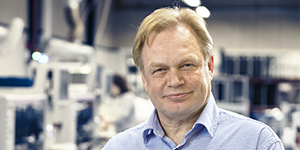Optimization and eliminating errors
As TKT Electronics is an EMS company that constantly works towards optimization and elimination of errors. They are always searching for new techniques, workflows and machinery, that can support their innovative way of working.
Article from www.core-emt.com
Work smarter – not harder
To work smarter, you don’t necessarily need a complex machine to do the job. The SMART:count machine is in its simplicity – no less than brilliant.
”While counting the components on reels, SMART:count prints the remaining components amount on the tape. It’s the same principle you see on power cable, where printed numbers indicate the amount of remaining cable.” explains Tommy Korsholt, CEO at TKT electronics.
SMART:count is the world’s first components “count & print” machine. The machine has just found its way to TKT Electronics. This little wonder is truly a smart worker. Making reel components count a onetime thing.
“This will also be a great daily benefit and help for our operators, when picking components on reels for a new job. The visible printed number of remaining components on each reel will be a great timesaver.” Tommy adds.
Timesaving by 15 – 20%
“We see great potential in smart counting every reel when it enters the TKT factory. This give us complete and accurate components count on every reel. Not only for the operator, but also when doing inventory count. We estimate that this will save us at least 15 – 20% time when doing inventory count.” Says Tommy Korsholt.
The operators at TKT find that the SMART:count machine is very user friendly, and requires minimal introduction to use.
This makes this supporting SMD count & print unit perfect for TKT.
Tommy Korsholt concludes: “To optimize a modern EMS company, you have to look at the company as a whole. Not only keep focus the production line. At TKT electronics we know that it is the interaction, tasks and workflow between machinery, employee and the company, that will ensure the continuance of optimization and eliminating errors at TKT.”

